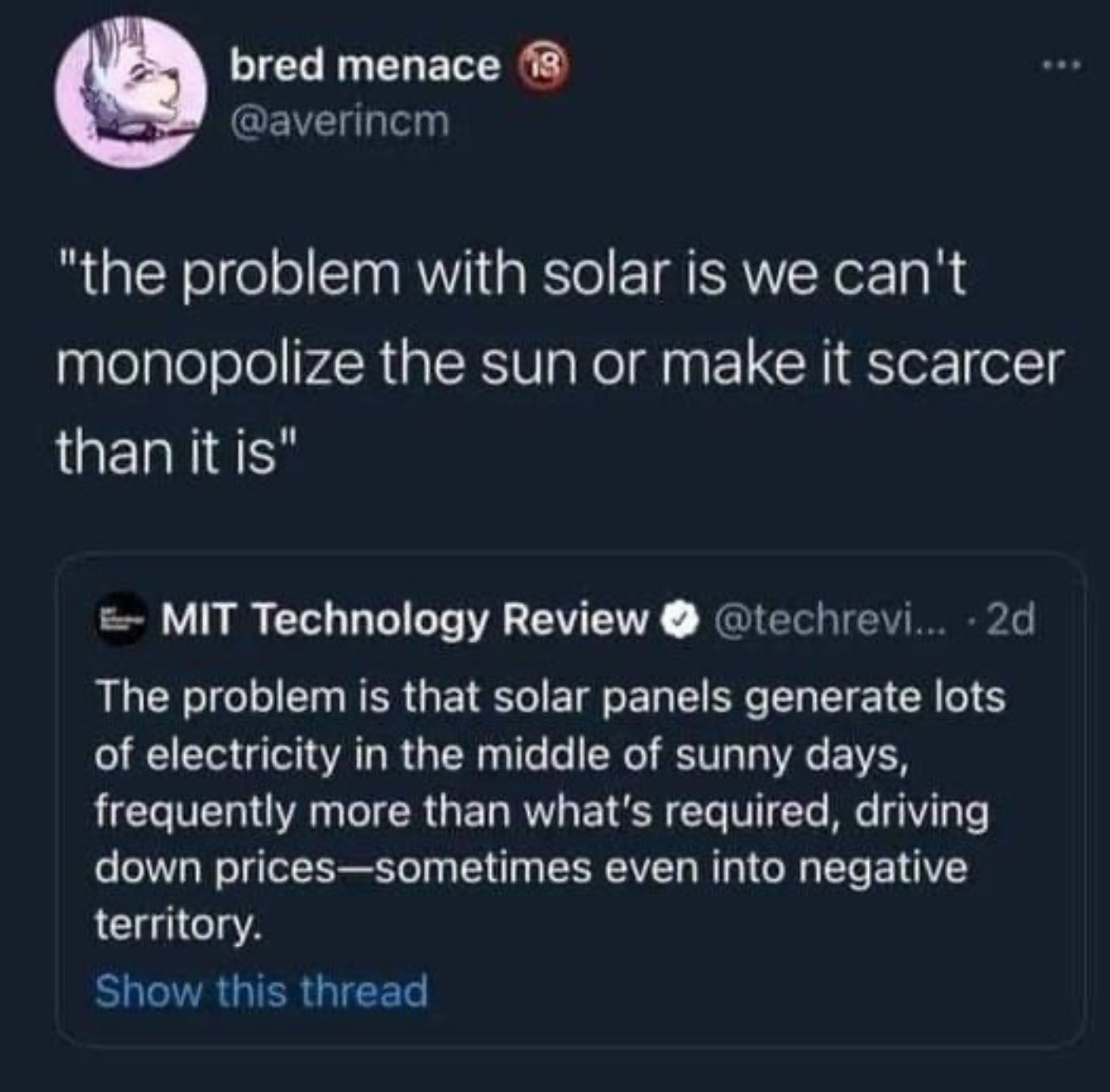this post was submitted on 02 Oct 2024
1345 points (95.6% liked)
Microblog Memes
7312 readers
2328 users here now
A place to share screenshots of Microblog posts, whether from Mastodon, tumblr, ~~Twitter~~ X, KBin, Threads or elsewhere.
Created as an evolution of White People Twitter and other tweet-capture subreddits.
Rules:
- Please put at least one word relevant to the post in the post title.
- Be nice.
- No advertising, brand promotion or guerilla marketing.
- Posters are encouraged to link to the toot or tweet etc in the description of posts.
Related communities:
founded 2 years ago
MODERATORS
you are viewing a single comment's thread
view the rest of the comments
view the rest of the comments

But the thing is, you CAN simply turn them off at the press of a button (or an automated script) so its really a complete non issue. As long as big solar installations control systems are accessible by the grid operators, it should be fine.
If you’re spending billions to build a solar plant that has to turn off all the time during peak hours then you’re wasting your money. That seems like a fundamental issue to me, not a non-issue.
Are there any solar plants that cost a billion dollars each?
Secondly, you want to over build solar, so that you have enough capacity during off peak hours. Grid storage is obviously the better solution, but seems not widely available enough yet.
It doesn’t matter how much solar you build; without storage you’ve got zero power available at night.
The issue with overbuilding solar is that you drive daytime electricity prices to zero so that everyone is losing money on all these solar plants. Furthermore, base load plants such as nuclear plants also start losing money and they have no ability to shut down during peak hours. So you end up driving the base load plants out of business and they shut down permanently. Now you have even less capacity available at night! This causes nighttime power to become extremely unreliable, potentially leading to rolling blackouts and skyrocketing nighttime energy prices.
Another issue that people rarely discuss is the quality of power on the grid. All the grids in the world operate on 50/60 Hz AC which must be carefully maintained at an accurate frequency and synchronized with the grid. The main base load turbines are the source of this waveform which is carefully monitored and adjusted to remain stable.
Solar panels produce DC power which needs to be converted into AC with an inverter and synchronized with the grid. The problem is that if all the base load turbines are taken off the grid then there is nothing for the solar inverters to synchronize with! Turbines are nice and stable because they’re literally an enormous, massive spinning flywheel. Without them you’ll have an extremely unstable system where all of the solar plants are trying to adjust their frequencies and phases to match each other and the whole thing wanders all over the place.
Ok, but what do you do when you're short of power at night? Keep in mind to turn on conventional power stations it's expensive & time consuming. Once they startup they need to stay on for a long while to be efficient & cheap.
The real solution is to store excess power in batteries. Lithium ion is too expensive to scale, Sodium ion batteries are economically & capacity viable AFAIK.
Thats just not what this post is about. Obviously storing is the way but until then yiu just gotta turn em off
I’ve read that gravity batteries and sand batteries are ecologically sound options that work on the scale needed to support large sections of the electrical grid.
https://interestingengineering.com/innovation/two-massive-gravity-batteries-are-nearing-completion-in-the-us-and-china
https://www.bbc.com/news/science-environment-61996520
I hesitate on
That first link is for a 10MW, 8 hour battery. 10MW is on the smaller end of generators, you’d need quite a few of these to start making an impact. For example, a small gas turbine is like 50MW, a large one is over 250MW.
And you could say “just build a lot of them” but the capacity per unit of area tends to be pretty low for these types of technologies.
Building them where we have ample space is okay. But now this power has to be transmitted, and we are already having a lot of problems with transmission line congestion as-is. The real advantage of energy storage is when it’s done local, no need for transmission lines.
Plus there’s permitting/stability issues as well. These wouldn’t work if the area was prone to earthquakes or other natural events.
That’s fair. They’re certainly imperfect, but a large improvement over electrolytic cells for large scale storage.
I think a more feasible potential technology for the grid are flow batteries.
They work through some kind of ion-exchange. Where they have two liquids, one charged and one not. By running power through a catalyzer, they move charges into one tank. Then you can apply a load across the catalyzer, and remove the charge as power.
I’m by no means an expert, but these are already pretty popular in Japan, and have started to make their way into the US.
Still definitely an expensive technology, but I’m hopeful that scale and investment can drive the cost down.
One of their biggest advantages over other technologies like Li-Ion is that their duration is independent of their capacity. Because the duration is only determined by the size of your tanks and the amount of liquid you have.
Meaning that you can take an existing 50MW, 4 hour plant and upgrade it to an 8 hour plant by doubling the size of the tanks and filling them up with the electrolyte. All without having to upgrade the catalyzer.
Edit: also worth mentioning they don’t have the same supply/environmental/recyclability concerns that lithium batteries do. I believe the electrolyte is relatively inert and does not degrade over time.